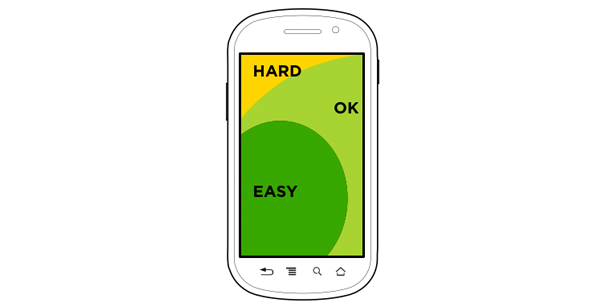 Summary: As more businesses create their own mobile apps (or mobile web apps), they’re entering uncharted territory. Many come from a background in traditional application development, and aren’t prepared for the changes that mobile development requires. In this article, we explore the key differences between the two development types, and share some mobile development tips.
Summary: As more businesses create their own mobile apps (or mobile web apps), they’re entering uncharted territory. Many come from a background in traditional application development, and aren’t prepared for the changes that mobile development requires. In this article, we explore the key differences between the two development types, and share some mobile development tips.
Over the last few years, we’ve seen mobility move from a “nice-to-have” to a top priority among businesses. According to Gartner’s 2015 CIO Agenda Report, mobile ranks as the third most important priority–up from fifth in 2014.
How important is mobile? Smartphone adoption increased 39% last year. In the US, web traffic from smartphones and tablets has surpassed desktop computers.
As mobile adoption grows, businesses are rushing to adapt. Some are creating brand new mobile apps. Others are building mobile versions of their existing applications.
The problem: Many of these businesses are new to mobile app (or mobile web app) development. They come from traditional application development–creating applications for desktop users. They’re not prepared for the differences between traditional and mobile development.
Today, let’s explore some mobile development tips for those who are venturing into it for the first time. How is mobile development different, and what aspects must you consider? Here are 7 mobile development tips you can’t ignore:
1. Consider context and user interaction
“Users on mobile are much more rushed, more distracted & far less patient than desktop web users,” says Garrett Perks, Founder & Creative Director at EvenVision. “Because of this, it isn’t hard to overemphasize the importance of simplicity. Strip out every non-critical feature and interface when converting desktop interfaces to mobile.”
One big mistake businesses make with their mobile apps: They try to mimic the capabilities of their desktop application in their mobile app. This ignores one of the biggest differences between mobile and desktop app development: User context.
Why is this so important? As mentioned in this article on Wired, “The world of mobile is significantly different than that of the desktop computer because mobile is all about context and that context is constantly changing.”
What does this mean for business? You can’t simply move your desktop application over to a mobile device. Understand your users and what they need to accomplish with your app.
“When creating a mobile version of a website or application, be sure to consider how your target user will interact with the software,” says Nick Bonatsakis, a mobile developer at Raizlabs Inc. “Mobile device screens are much smaller, interactions tend to be much quicker, and expectations are very different than those present for desktop applications. Don’t try to port your entire website or desktop application to mobile, your users will be overloaded and on a 4-inch screen, it just won’t make any sense. Rather, choose the features that matter most to on-the-go users and focus on making those features really work well.”
2. Recognize the importance of user experience

Mobile users have more mobile app options than ever before. If your app is confusing, or doesn’t meet their expectations, they’ll move on to another option.
This article sums up the modern mobile user perfectly: “Mobile customers are intolerant and fickle. (You know you are). If your app isn’t a knockout on first impression, it’s probably going to be deleted or will be forgotten on their smartphones.”
What does this mean for businesses? You can’t just throw together a mobile app and expect your employees to use it. As explained below, the user experience is everything.
“User experience (UE) is KEY,” says Mike Solow, CEO of Idea Harvest, LLC. “Whether you’re a business that will rely solely on this app for revenue generation or a large company augmenting their product offering, you have a very short runway to win over new users in the app world. If you have never developed an app before, you would be wise to carefully seek outside assistance in this area because app development is really not much like developing for the desktop PC. The simple truth is most app downloads result in a deletion from the user’s device, and that is largely due to poor user experience. Personally, I’d advise that simplicity is the best policy so if you’re re-skinning an existing program into a mobile app you should stick to the core functionality initially. Design a simple, clean, easy interface that you can build on as you go forward.”
3. Understand the limitations of a touch-based interface
Another common mistake businesses make with mobile apps: They don’t address the differences between a touch-based interface and a mouse-based interface.
For instance, a mouse-based interface is precise. Tiny buttons and small clickable areas work. Button location isn’t big issue.
A touch-based interface is not precise. It requires buttons large enough for a thumb press. Additionally, button location is very important. Buttons must be located within the “reach zone”–the area on the screen reachable with a thumb.
“Designing an application for a touch-based interface requires a fundamental shift in development,” says Brian Duffey, Application Architect at mrc. “From the studies I’ve seen, buttons must be at least 72×72 pixels to account for the average thumb width. Also, you must take into account that users typically hold their phones with one hand. You must design the interface with that fact in mind–keeping the common tasks in the bottom half of the screen for easy access.”
4. Stick with platform best practices
Some businesses make the mistake of trying to put their own twist on their mobile app. While providing a unique experience isn’t necessarily a bad thing, be careful. There’s a fine line between a unique app, and one that confuses your users.
Why is this so important?
Every mobile platform has its own set of design standards. These standards are familiar to the users. They expect buttons to look, feel, and function in a specific way. If you provide an interface that differs too greatly from their expectations, your app will confuse the users.
“If you go native, honor platform conventions and best practices,” says Bonatsakis. “Both iOS and Android have their own very rich set of UI controls and interactions, as well as great documentation on UX guidelines. Don’t build an iOS app and port it screen-for-screen to Android, the platform has a completely different look and feel and your app will not feel at home for Android users.”
5. Pay attention to perceived speed

According to recent research, speed is even more important for mobile apps than it is for typical websites. Users will not tolerate mobile apps that are slow to open or operate.
But, what does application “speed” actually mean? Traditionally, it refers to response time–how quickly the application responds to user requests. But, research has found that lowering the response time isn’t the only way to improve application speed. In fact, “perceived performance” may actually be more important than actual performance.
“While application speed is critical to mobile app usability, we’ve found that it goes a step beyond that,” says Duffey. “It’s not so much how fast the application is, as much as how fast the application feels to the user. It’s the perceived speed that makes the difference. This can be accomplished by adding touch states to your buttons or using unique loading animations, among other things. In making the application feel fast and responsive, the user believes it is faster.”
6. Break away from long product-release cycles
“Don’t plan your development too far, the mobile world is evolving so fast,” says Omer Chehmer, the Head of Mobile Communications for Last Minute Travel. “You need to act fast to every new trend or feature that’s coming out in order to align with the market.”
The rise of mobile brings major changes to traditional development methods. As Gartner explained at their recent Digital Workplace Summit, IT must adjust the way it manages product releases as the cadence of mobile release cycles speeds up.
In short, businesses can’t approach a mobile development project in the same way that they approached traditional development projects of the past. Mobile development requires agility. It requires short release cycles.
“Rapid decision making is critical in a dynamic digital environment,” says Dev Gandhi, CEO and Founder of moBack. “Twelve-month product-release cycles are a relic. Organizations need to move to a cycle of continuous delivery and improvement, adopting methods to increase the pace of innovation. Continuous improvement requires continuous experimentation, along with a process for quickly responding to bits of information.”
7. Bridge the gap between security and accessibility
Mobile apps bring a new set of security challenges. While we can’t get into every security risk in this article, OWASP provides a great list of the top 10 mobile security risks to watch for.
But, perhaps one of the biggest security risks come in the form of the users themselves. Not only must you create a secure application, you must account for the fact that users aren’t aware of proper mobile security practices. The challenge: How do you balance security with data accessibility?
“Security is often one of the most important aspect of use-experience as the users do not want to re-enter their credentials, yet maintain secured access to the app,” says Sachin Agarwal, Vice President of Strategy at Akana. “The APIs can implement Oauth, which can improve the user experience by providing restricted access to the app on behalf of the user. Because of the limited real estate available in a mobile app, personalization and delivery of contextual information is critical, something that the APIs can be tuned to deliver, once the user context and credentials have been established.”
Summary
Now, these are just a few differences between mobile and traditional development. If you would like to add anything to this list, I’d love to hear it. Feel free to share in the comments.

As a Webmaster i also realize this, my mostly sites receiving traffic from mobile so i believe in few upcoming years mobile traffic will more increase
Btw Informative Thread
Always Be happy.
Hey Joe Stangarone Great Article!! I really appreciate your post and agree with you. Thanks for good information and way of explaining., This will be really useful. This article has provided me with an insight about Mobile vs. Traditional Development. I am agree with all point and given summary also “As more businesses create their own mobile apps (or mobile web apps), they’re entering uncharted territory”.
Good blog post.
Some of those differences I covered together with my co-workers while devising an article on a similar topic on our blog, but we also pointed out to some other differences (we located the accents differently), I’m leaving a link behind, check if you like: https://untitledkingdom.co/blog/web-mobile-development-5-differences/
Hey, I love to read mobile application related blogs. You have shared such an amazing tips. Thanks.